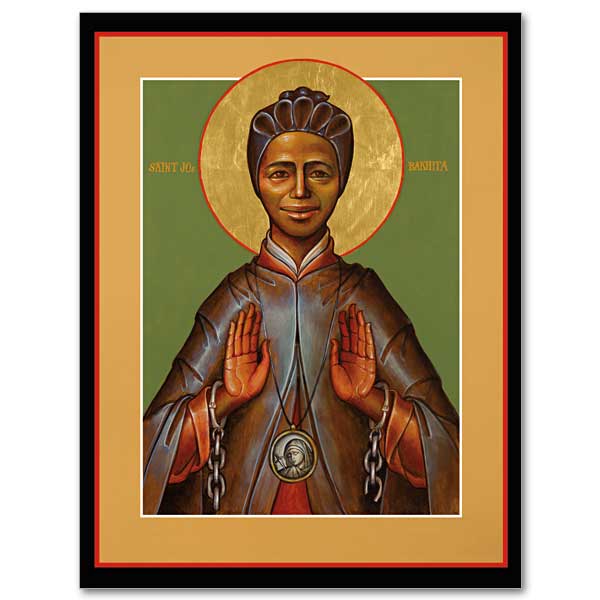

| Item Number | Description | Price Each | Quantity | Total | Action |
|---|---|---|---|---|---|
| ICA025 | 4" X 5" ICON ON WOOD |
$15.99 |
|
$15.99 | |
| ICA125 | 6" X 8" ICON ON WOOD |
$26.99 |
|
$26.99 | |
| ICA225 | 8" X 10" ICON ON WOOD |
$37.99 |
|
$37.99 | |
| ICA325 | 10" X 13" ICON ON WOOD |
$54.99 |
|
$54.99 |
St. Josephine Bakhita, patron saint of victims and survivors of human trafficking and slavery, offers hope to victims and survivors that as children of God, victims are already free. Born in 1869, St. Josephine Bakhita was captured as a child by slave traders who sold and re-sold her. Eventually purchased by an Italian diplomat and taken to Italy, she learned about God through the Canossian Daughters of Charity. She found the grace of God to forgive her captors, providing an invaluable model for survivors of all forms of human trafficking and slavery: to be truly free, one must forgive.
Wood-mounted icons are on 5/8" ProWood® Medium Density Fiberboard (MDF) with a wood-look foil finish, with tee-slots milled in the back for easy hanging. Icons are finished in classic cherry to replicate the traditional icon red, in keeping with Byzantine tradition. (Ancient icon board edges were frequently coated with red bole, a form of clay). Each mounted icon comes with a descriptive pamphlet explaining the symbolism and history of the image.
Please allow 5-10 business days for orders of 20 or more icons.
Our icon designs are also available as unmounted prints in sanctuary-size enlargements up to 38 inches wide. The latest technology enables enlargement without sacrificing quality. We do not currently have the ability to mount these prints on wood or any other material. You may purchase your own frame from a custom frame shop. Call 800-889-0105 for pricing and ordering.
In St. Josephine Bakhita, patron saint of victims and survivors of human trafficking and slavery, we find the model for one who knows the suffering of both victims and survivors but found great hope through God. In so doing, as Pope John Paul II said of St. Josephine, she became “a shining advocate of genuine emancipation.”
Born in 1869 she was captured as a child by slave traders who sold and re-sold her. Eventually she was purchased by an Italian diplomat who took her to Italy with his family. There, through the Canossian Daughters of Charity, St. Josephine learned about God, and through God, as Pope Benedict the XVI wrote she found “hope” —no longer simply the modest hope of finding masters who would be less cruel, but the great hope…Through the knowledge of this hope she was “redeemed”, no longer a slave, but a free child of God…the liberation that she had received through her encounter with the God of Jesus Christ, she felt she had to extend, it had to be handed on to others, to the greatest possible number of people. The hope born in her which had “redeemed” her she could not keep to herself; this hope had to reach many, to reach everybody.
Victims of human trafficking, referred to as “contemporary forms of slavery,” have many problems resulting from abuse and exploitation. Most common, perhaps is their loss of hope, which was experienced by St. Josephine Bakhita.
As a survivor of slavery, St. Josephine still bore the physical and mental scars of her captivity. She suffered torture at the hands of her owners. On one occasion she was cut 114 times and salt was poured into her wounds. Even on her death bed she pleaded “Please, loosen the chains, they are so heavy.” This led to the creation of this icon: St. Josephine Bakhita, a free child of God, with the broken chains of slavery.
Beyond surviving slavery and serving God, St. Josephine found the grace of God to forgive her captors. Even after the physical chains were broken, St. Josephine did not seek revenge against those who hurt her but forgave them, providing an invaluable model for survivors of all forms of human trafficking and slavery: to be truly free, one must forgive. “If I were to meet the slave-traders who kidnapped me and even those who tortured me, I would kneel and kiss their hands, for if that did not happen, I would not be a Christian and Religious today.”
St. Bakhita is depicted in a frontal pose from the waist up, with her hands held in the "orante" or prayer gesture common in icons of virgin saints—especially the Virgin Mary. This icon varies from the model in that Bakhita wears the chains of slavery—but broken, both spiritually and literally. Spiritually, the chains were broken with her conversion to the Christian Faith, and literally by her choice to serve God as a nun, effecting independence from her "owner" family.
She wears the original habit of the Canossian sisters, with its shades of black and brown. A highlight of blue reflects off Bakhita's garments, which, in iconographic language, indicates the presence of Divine Wisdom. The use of gold indicates the presence of Divinity. The use of green in the icon is a reference the saint's African homeland of Sudan, as well as the indwelling of the Holy Spirit. Finally, we see suspended around St. Bakhita's neck, an image of the Sorrowful Mother, which is the traditional Marian devotion of her order.